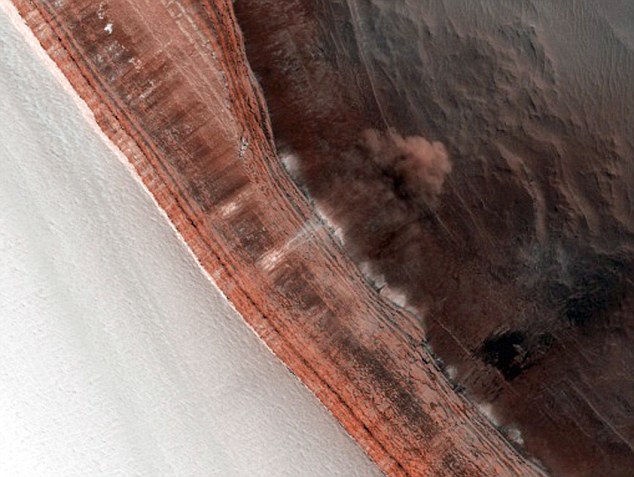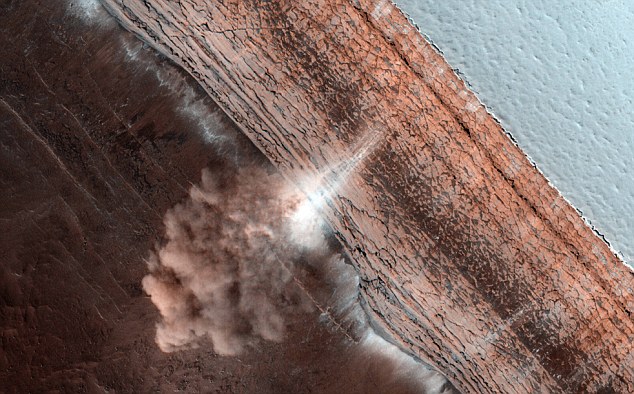It looks like you're using an Ad Blocker.
Please white-list or disable AboveTopSecret.com in your ad-blocking tool.
Thank you.
Some features of ATS will be disabled while you continue to use an ad-blocker.
7
share:
It's not the first avalanche captured by the HiRISE camera aboard the Mars Reconnaissance Orbiter - Nasa first detected the phenomenon in 2008, believed to be caused by a thin 'crust' of frozen carbon dioxide (dry ice) which forms during the Martian winter.
This is a good catch by NASA although looking at the pics it looks a little more than a thin crust of frozen carbon Di-oxide to me if it can be seen from space
www.dailymail.co.uk...
Very cool photo's!
I'll embed them for you.

And this is an earlier pic from March 2010

I'll embed them for you.

And this is an earlier pic from March 2010

reply to post by Qumulys
Thanks for embedding them m8,do they look a little large to be thin Dry ice,I mean you can see them from space
Thanks for embedding them m8,do they look a little large to be thin Dry ice,I mean you can see them from space
It might be just the angle the pics were taken from.....
It looks weird since there does not seem to be any disturbance from the top. You have the white color, then the clean line of brown, then the avalanche. There is nothing at the top to suggest it came from there, which is weird.
Even going with the mindset of it being an overhang that just snapped, there is no disturbance at the top that would suggest it came from there. If it did you would think the top would show uneven breaks / lines from where the connection broke.
Then again its not Earth and it may be the way things work on Mars.
It looks weird since there does not seem to be any disturbance from the top. You have the white color, then the clean line of brown, then the avalanche. There is nothing at the top to suggest it came from there, which is weird.
Even going with the mindset of it being an overhang that just snapped, there is no disturbance at the top that would suggest it came from there. If it did you would think the top would show uneven breaks / lines from where the connection broke.
Then again its not Earth and it may be the way things work on Mars.
reply to post by Xcathdra
Yes thats true but the point im making is NASA claims its a thin crust of frozen carbon di-oxide (dry ice) it looks a lot more than that if it can be photographed from space is there more water on the surface than they are letting on what do you think Xcathdra?
Yes thats true but the point im making is NASA claims its a thin crust of frozen carbon di-oxide (dry ice) it looks a lot more than that if it can be photographed from space is there more water on the surface than they are letting on what do you think Xcathdra?
reply to post by Xcathdra
I think its more like when ice builds up inside a freezer, in this case though its frozen co2, and on the top of a cliff face. I think its just the weight of itself that leads it collapse, think like when a glacier drops chunks off into the sea.
What amazes me the more I think about it is the dramatic difference at the two heights! In the cold depths of Mars, I would expect this frozen co2 to be everywhere!?
EDIT: Even though this pic is from space, I'm guessing it to be an area perhaps no bigger than... 5-10 sq km? I'd imagine that ice sheet around 2-10 meters thick perhaps. The lower gravity on Mars would mean it would build up higher before collapse than here on earth I'd suspect.
I think its more like when ice builds up inside a freezer, in this case though its frozen co2, and on the top of a cliff face. I think its just the weight of itself that leads it collapse, think like when a glacier drops chunks off into the sea.
What amazes me the more I think about it is the dramatic difference at the two heights! In the cold depths of Mars, I would expect this frozen co2 to be everywhere!?
EDIT: Even though this pic is from space, I'm guessing it to be an area perhaps no bigger than... 5-10 sq km? I'd imagine that ice sheet around 2-10 meters thick perhaps. The lower gravity on Mars would mean it would build up higher before collapse than here on earth I'd suspect.
edit on 10-2-2012 by Qumulys because: (no reason given)
reply to post by Qumulys
Some good points... However when glaciers on Earth break off, its not a perfect line like it is in the pictures. Like I said it might be the angle the pics were taken from. I just found it goofy.
reply to post by Bilder
I think when it comes to planetary bodies and NASA, we are essentially repeating the discovery of the new world. Lots of misconceptions, wrong guesses / conclusions, constant discovery of new factors that constantly changes the puzzle.
Until we get feet on the ground on Mars all we can do is speculate.
Some good points... However when glaciers on Earth break off, its not a perfect line like it is in the pictures. Like I said it might be the angle the pics were taken from. I just found it goofy.
reply to post by Bilder
I think when it comes to planetary bodies and NASA, we are essentially repeating the discovery of the new world. Lots of misconceptions, wrong guesses / conclusions, constant discovery of new factors that constantly changes the puzzle.
Until we get feet on the ground on Mars all we can do is speculate.
edit on 10-2-2012 by Xcathdra because: (no reason given)
Full size image of one avalanche at the left on this link is 6 x 10
km. Many close MRO images are only 2km wide. I believe at the top of the slides chunks are largely solid and as they fall they hit the sides kicking
up dust as well as the CO2 ice sublimation, turning to gas without going through a liquid state. Water ice would do that just being on the surface,
which is why any water ice on Mars wont be on the surface, it would quickly turn to gas and eventually be lost to space.
If anyone has been to the crater in Arizona, they would first notice the upper lip drops off like a cliff for quite a was before the curved interior of he crater is reached. For those two reasons is why I think its hard to see the mass at the top dropping, plus the dust kicked up will linger for a while. We all can picture a relatively dry Angel Falls of Yosemite Ribbon Falls spreading out on the way down from a very small source. Off topic, but I understand at times the water never reaches the ground under Angel Falls, its wet, but not like a base of a waterfall, more like just being in a mist.
If anyone has been to the crater in Arizona, they would first notice the upper lip drops off like a cliff for quite a was before the curved interior of he crater is reached. For those two reasons is why I think its hard to see the mass at the top dropping, plus the dust kicked up will linger for a while. We all can picture a relatively dry Angel Falls of Yosemite Ribbon Falls spreading out on the way down from a very small source. Off topic, but I understand at times the water never reaches the ground under Angel Falls, its wet, but not like a base of a waterfall, more like just being in a mist.
edit on 10-2-2012 by Illustronic because: (no reason given)
new topics
-
Mysterious Spiral 'UFO' Sightings Reported Across US, Europe
Aliens and UFOs: 3 hours ago -
The Dark Pyramid of Alaska and the Why Files take on the subject
Whistle Blowers and Leaked Documents: 7 hours ago
top topics
-
The Dark Pyramid of Alaska and the Why Files take on the subject
Whistle Blowers and Leaked Documents: 7 hours ago, 9 flags -
Israeli strikes on southern Gaza city of Rafah kill 22, mostly children, as US advances aid package
Middle East Issues: 13 hours ago, 5 flags -
Mysterious Spiral 'UFO' Sightings Reported Across US, Europe
Aliens and UFOs: 3 hours ago, 2 flags
active topics
-
Really Unexplained
Paranormal Studies • 50 • : Beesnestbomber -
Mysterious Spiral 'UFO' Sightings Reported Across US, Europe
Aliens and UFOs • 9 • : TheMisguidedAngel -
Zionists of ATS assemble
Political Issues • 160 • : 19Bones79 -
October 7th: The Crumbling Facade of a Western Security Asset
Above Politics • 103 • : Justoneman -
The Vaccine Injured
Medical Issues & Conspiracies • 17 • : PrivateAngel -
Documenting President JOE BIDEN's 2024 Re-Election Failures As They Happen.
2024 Elections • 75 • : Vermilion -
-@TH3WH17ERABB17- -Q- ---TIME TO SHOW THE WORLD--- -Part- --44--
Dissecting Disinformation • 805 • : brewtiger123 -
ALERT - U.S. President JOE BIDEN Examined and Found NOT OF SOUND MIND.
2024 Elections • 74 • : WeMustCare -
Shocking moment four men 'try to force Jewish pedestrian into car boot' in North London
Breaking Alternative News • 87 • : 19Bones79 -
Prophets versus priests; - Getting God's help
Religion, Faith, And Theology • 11 • : Astyanax
7
